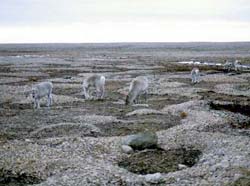Rain will take greater toll on reindeer, climate change model shows

Reindeer graze on the island of Spitsbergen, one area being affected by more rain-on-snow events that can cut the animals off from their food supply. (Photo credit: Jaakko Putkonen)
Jolly Old St. Nick depends on his team of reindeer to complete his Christmas rounds on time. But new research indicates that, because of the world’s changing climate, Santa might want to start thinking of new ways to power his sleigh.
Scientists have long known that rain falling on snow in the far northern latitudes during winter months can play havoc with herds of hoofed animals – primarily reindeer, caribou and musk ox – that feed on lichens and mosses growing on the soil surface. In one recent instance on the far-north island of Spitsbergen, soil temperatures that normally stay well below freezing in winter months rose to near freezing and remained there for 10 days or so because rainwater seeped through the snow and water pooled at the soil surface. Finally the water froze, so soil temperatures dropped again, but the ice coating kept the animals from their food supply.
“You have an ice layer at the surface several centimeters thick that even a person couldn’t get through without tools,” said Jaakko Putkonen, a research assistant professor of earth and space sciences at the University of Washington.
Such an ice layer lasts until summer, when the snow and ice eventually melt. And it is not uncommon for several rain-on-snow events to happen in the same winter.
“I have seen soil temperatures remain at the freezing point for as long as two months because of the slowly freezing water below the thick snowpack,” Putkonen said. “Even when ice layers are not impenetrable, the warmer soil surface temperatures promote the growth of fungi and toxic molds among the lichens, so the animals avoid those areas.”
In addition, the top of the snow can be covered with a layer of ice that the animals can’t penetrate, and that can damage their hooves.
“During those periods the herders have to start bringing out hay because the reindeer just can’t get food,” he said.
It appears that climate change will make things substantially worse.
Putkonen developed a model of snow and soil heat generation to gauge the effects of climate change in areas such as northern Alaska and Canada, Greenland, northern Scandinavia and Russia, and Spitsbergen, a Norwegian island midway between Norway and the North Pole.
The current scientific understanding of where and when rain-on-snow events happen is based on observations over a number of years. A computer model filled in missing data between areas where observations were made. To analyze the effects of human-caused climate change, Putkonen and his UW colleague Gerard Roe studied the results of the global climate model for the decade of 1980 through 1989 and found that it correlated quite closely with actual observations during that period.
“If anything, the model understated the results,” Putkonen said.
Looking ahead to the decade of 2080-89, the model shows a 40 percent increase in the land area affected by rain-on-snow events. Typically those events happen closer to coastal areas, but the model predicts they will move much farther inland. That will mean major impacts not only on reindeer herds but also on the people who depend on them for their livelihood.
“The bottom line is that the rain will penetrate farther into the interiors of the continents, where most of the reindeer are,” he said. “This is a consequence of climate change that specifically affects native peoples. They have depended on reindeer and caribou for thousands of years, but they don’t have the means or the ability to deal with these effects.”
The research by Putkonen and Roe, a postdoctoral researcher in the UW Quaternary Research Center, will be published in an upcoming issue of Geophysical Research Letters, a publication of the American Geophysical Union.
Putkonen hopes this work will lead to more in-depth study of how reindeer and other large ungulates, or hoofed animals, living in northern climes will be affected by global climate change. For instance, it is unclear how much the loss of food because of rain-on-snow events affects the animals’ mortality, and there is little understanding of how much greater the affect will be as those events occur farther inland, where those animals live.
For more information, contact Putkonen at (206) 543-0689 or putkonen@u.washington.edu, or Roe at (206) 543-0570 or gerard@atmos.washington.edu
Media Contact
More Information:
http://www.washington.edu/All latest news from the category: Ecology, The Environment and Conservation
This complex theme deals primarily with interactions between organisms and the environmental factors that impact them, but to a greater extent between individual inanimate environmental factors.
innovations-report offers informative reports and articles on topics such as climate protection, landscape conservation, ecological systems, wildlife and nature parks and ecosystem efficiency and balance.
Newest articles

First-of-its-kind study uses remote sensing to monitor plastic debris in rivers and lakes
Remote sensing creates a cost-effective solution to monitoring plastic pollution. A first-of-its-kind study from researchers at the University of Minnesota Twin Cities shows how remote sensing can help monitor and…

Laser-based artificial neuron mimics nerve cell functions at lightning speed
With a processing speed a billion times faster than nature, chip-based laser neuron could help advance AI tasks such as pattern recognition and sequence prediction. Researchers have developed a laser-based…

Optimising the processing of plastic waste
Just one look in the yellow bin reveals a colourful jumble of different types of plastic. However, the purer and more uniform plastic waste is, the easier it is to…



